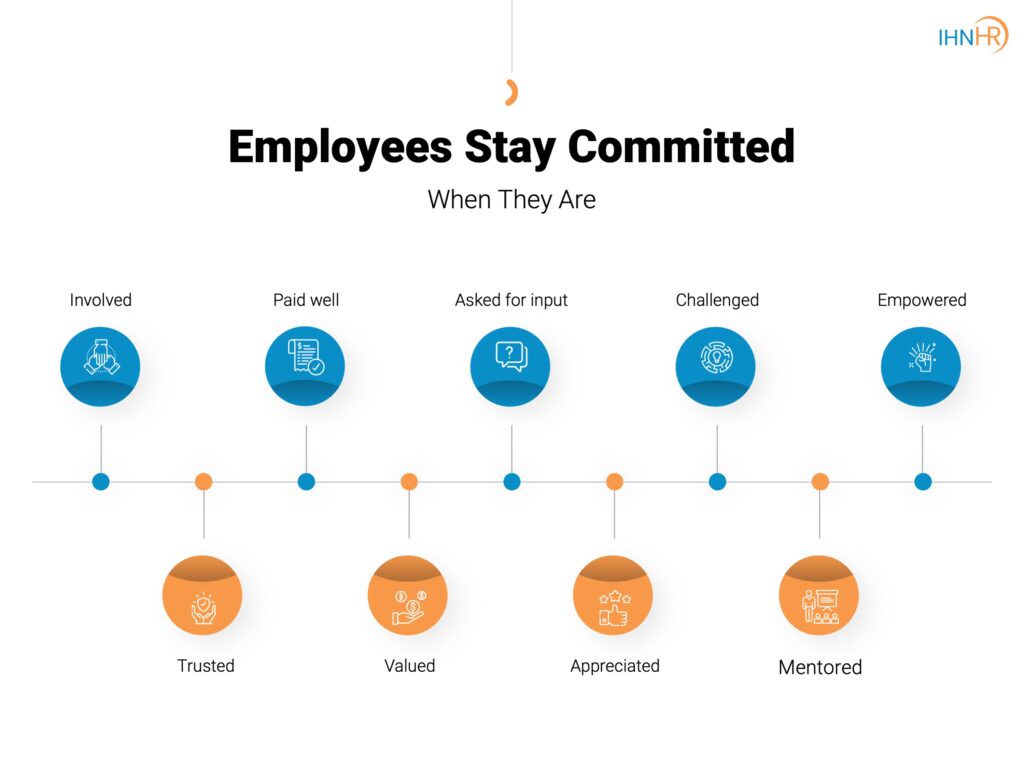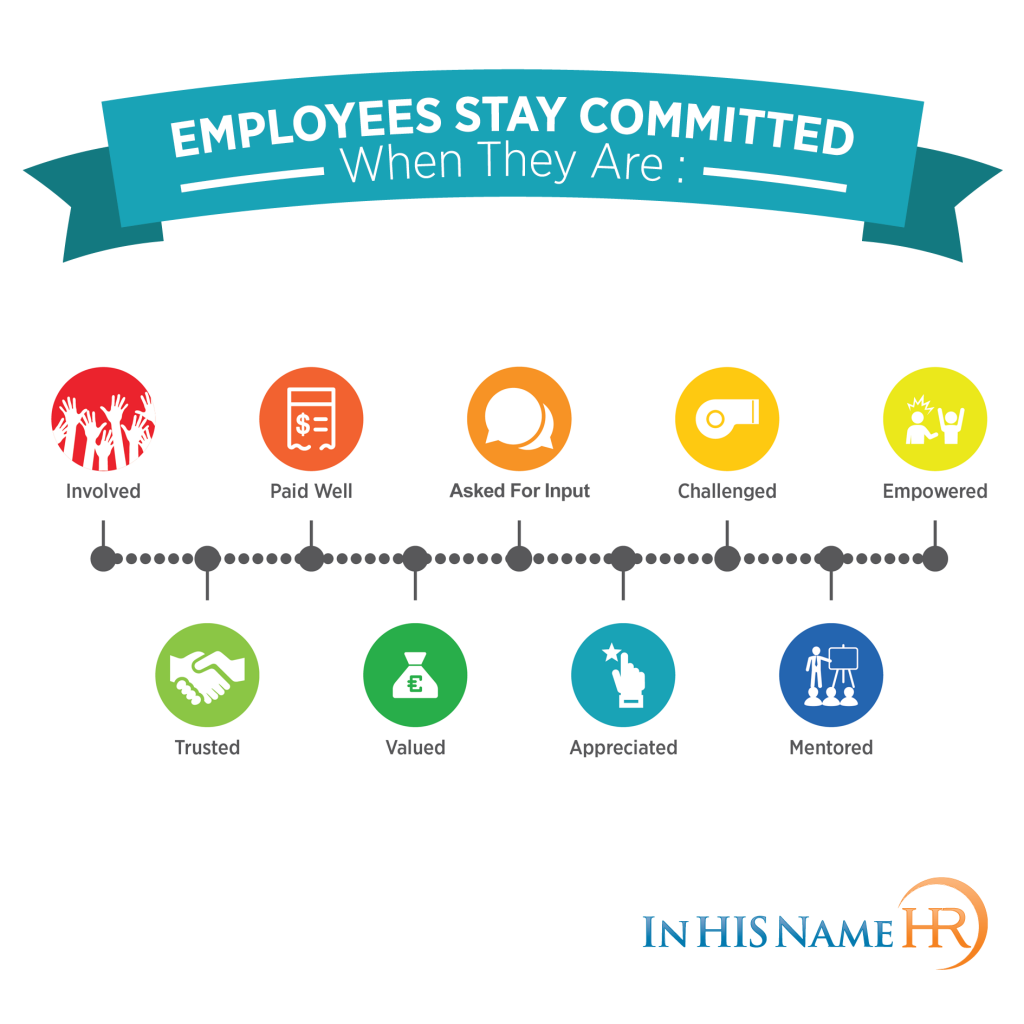
Dec 14, 2018
This blog series focuses on nine areas that keep employees committed to your organization. In our opinion, employees stay committed when they are Involved, Paid Well, Asked for Input, Challenged, Empowered, Trusted, Valued, Appreciated, and Mentored.
 Do Your Employees Feel Valued?
Do Your Employees Feel Valued?
Every organization that hopes to achieve its goals and objectives needs employees to commit to the task. As employers, it falls to us to keep our employees motivated. As any employer knows, unmotivated employees contribute less to reaching organizational goals.
Motivated team members are the hallmark of a progressive organization. In fact, they often go above and beyond for their organization.
What makes them so motivated? It’s simple—they feel valued.
Organizations that go out of their way to make their employees feel valued often reap great rewards. As a manager, one of the most important things you can do is to show your team their value.
And while it’s important from a productivity point of view, that’s not the only reason. From a Christian perspective, we all deserve to feel valued. To know that our contribution makes a difference.
To understand that our work is for the greater good.
How to Make Employees Feel Valued
There are several ways to contribute to an employee’s sense of value. For example, making it clear that every role has a direct impact on the good of the organization.
As a manager, it’s vital never to trivialize any of your employee roles. Employees must understand that their efforts help to cut a clear path to success for the organization. There are a variety of ways to cultivate a high sense of value among the workers in your organization, including:
Communication: Open the channels of communication between employees and leadership. It’s important to listen to employee opinions and follow suggestions where appropriate.
Making changes based on employee feedback sends a clear signal of value and appreciation.
Communication should always be professional, but never stiff or distant.
A leader should always be willing to facilitate smooth communication with employees. Open and natural communication with the leadership team makes employees feel valued.
Showing Appreciation: The best way to motivate employees to do more is to show appreciation for tasks already done. On a personal level, a “Thank you for a job well done” can lift employee morale faster and higher than just about anything else.
Many organizations send appreciation emails to employees after a significant win. Events dedicated to rewarding employees are also great on a yearly or even monthly basis. This type of reward system spurs employees to do more. But the organization must be consistent and transparent in its dealings to ensure sustainability.
Encouraging Work–Life Balance: As a manager, it’s important to appreciate and respect that employees have a life outside of work. Placing heavy value on work at the expense of employee personal lives is counterproductive. Work schedules should be flexible, even if only to a small extent. Managers should not be quick to say no when employees request time off to attend personal events.
A recent article in Accounting Today stated, “A new global survey via professional services network World Services Group found that among young professionals in North America (as well as the rest of the world), work–life balance was the biggest priority in their professional lives, beating out wealth and leadership opportunities.”
For any organization to produce results, you need the full commitment of all employees. Leadership should never simply expect employees to have the desire to move the organization forward.
The reason behind this is clear. Employees often have a lesser stake in the organization. Yet, as a manager, if you’re able to make your employees feel valued, there is no limit to what can be achieved.
__________________________
In HIS Name HR helps organizations build high-performance Human Resources programs. Visit them at In HIS Name HR .
Mark A. Griffin is the founder and chief consultant of In HIS Name HR LLC. Connect with him on LinkedIn or Twitter.
Mark A. Griffin | Blog, Christian Higher Ed HR, Human Resources

Dec 7, 2018
This blog series focuses on nine areas that keep employees committed to your organization. In our opinion, employees stay committed when they are Involved, Paid Well, Asked for Input, Challenged, Empowered, Trusted, Valued, Appreciated, and Mentored.
How to Show Employees You Trust Them
In order for any organization to achieve high performance in these difficult times, it’s important that your employees be committed to your organization and your organization’s success. In order to gain the commitment of your employees, leaders or managers need to include employees in some of the organization’s decision making and show they trust the employee to do what’s in the organization’s best interest.
The human resources department may be able to give you tips on some ways to engage your employees and build trust. In the meantime, here are some ways to help you build employee trust and commitment.
Show Your Employees You Value Their Input
One of the most important ways to secure your employees’ engagement and commitment is to show you value their input and contribution to making your organization a success. Everyone wants to feel valued and showing each employee that you appreciate their contribution earns their trust and makes them more committed to you and the organization.
In order to garner input, you must have a foundation of trust. Trust is an “evolving thing that ebbs and flows,” says David DeSteno, a psychology professor at Northeastern University and author of The Truth About Trust. If you don’t have trust, more than likely you won’t get honest and in-depth input from employees. In fact, we often find that when trust is lacking, it’s rarely worth the time and effort required to survey or interview employees for ideas—they just don’t have the energy, or care to contribute earnestly.
Goal Setting
In order for any organization to move ahead, they need to set goals. Use goal setting to build trust by first setting your top-level goals and then allowing your employees to set their own short-term goals and objectives to reach yours. You may be surprised to discover that, given the opportunity, your employees will set higher short-term goals and clearer objectives than your HR department likely would.
You can then use the annual review process to assess achieving the overall organizational goals and how well your employees have stepped up to do so.
Let Your Employees Define Their Job Description
Another thing your HR department or supervisor can do is to let your employees define their own job description. By encouraging your new employees to research the best practices in their area of responsibility and examine what experts in their field think their job should entail before writing out that job description, not only will that job description be far more detailed but they will include much more in the job description than your own HR department would.
When you give your employees the responsibility of defining their own roles in your organization, they will be far more willing to shoulder added responsibility than they otherwise would.
Problem Solving
One of the best ways to show your employees that you trust them, and to solidify their commitment to you, is by involving them in problem solving. Whether you are trying to bring a project in under budget, cut expenditures to make more profit, or deal with other organizational issues, sharing critical or even confidential information and allowing your employees to solve the problem will definitely solidify their engagement with your organization and strengthen their commitment to the organization and its welfare.
These are just four ways in which you can demonstrate that you trust your employees. What has been your experience? How do you managerially or corporately develop and demonstrate trust with your people? Leave comments below. We value your contribution.
______
In His Name HR helps organizations build high-performance Human Resources programs. Visit them at In HIS Name HR.
Mark A. Griffin is the founder and chief consultant of In His Name HR LLC. Connect with him on LinkedIn or Twitter.
___________
In His Name HR helps organizations build high-performance Human Resource programs. Visit them at In HIS Name HR or e-mail them.
Mark A. Griffin is the founder and chief consultant of In His Name HR LLC. Connect with him on LinkedIn or Twitter.

Mark A. Griffin | Blog, Christian Higher Ed HR, Human Resources

Nov 29, 2018
This blog series focuses on nine areas that keep employees committed to your organization. In our opinion, employees stay committed when they are Involved, Paid Well, Asked for Input, Challenged, Empowered, Trusted, Valued, Appreciated, and Mentored.
Are Your Employees Truly Empowered?
An organization’s most powerful asset is its workforce, and many leaders lose sight of that. While the metrics may center on the finances, enrollment numbers, on-time delivery, user statistics and customer feedback, ultimately it’s the frontline employees who are giving their all to keep the organization strong. Our experience is that no matter the product or services offered, many organizations miss the mark when it comes to how to empower employees.
To that end, being sure to empower your employees will go a long way toward both increasing productivity and lowering attrition rates, not to mention ensuring strong interaction between employees and the people you serve.
From a Christian perspective, it behooves us to empower everyone we can, and doing God’s work is just as vital at work as it is at church, at home, and everywhere we interact with others.
From a leadership perspective, we trust our employees to represent the organization in the best possible way—but this can be faulty logic if employees do not feel as though their contribution is vital to the health of the organization.
Failing to make employees feel needed and empowered can lead to resentment, poor performance and high staff turnover. It can wield a real impact on the success of your organization in several ways.
For example, a 2017 Gallup poll showed 85% of employees are not engaged or actively disengaged at work. —disengaged workers have been found to cause corporate losses of between $450 and $500 billion per year.
Recent studies have also shown that promoting employee happiness leads to an increase in engagement, which ultimately encourages employees to take ownership in the success of the organization.
How can you empower your employees? Here’s our list of ways to ensure they feel empowered:
Define a clear path to success
True leadership means promoting a clear vision of organizational success and enabling your team to take ownership in order to reach that success.
By helping to define the organization’s vision, along with defining the roles people need to fill in order to contribute to the overall success of the organization, you succeed in giving your staff the clarity they need to move the business ahead.
Trust is vital
One of the most critical steps you can take to help your employees feel empowered is to demonstrate that you trust their expertise and have faith in their decisions.
By allowing your employees to use their knowledge to brainstorm and implement viable processes and solutions, you demonstrate your belief that their contribution is directly responsible for the success of your venture.
While many organizations take the attitude that developing process is something only management can do, your frontline staff can almost always provide you valuable input, so treat their knowledge as an asset.
Communicate
By communicating clearly and ensuring that employees always know exactly where they stand, you open the door for a balanced, happy workforce.
From day-to-day expectations to organizational-wide policies, and everything in between, making sure that your communication is both heard and understood leaves little room for misunderstanding, and helps employees to feel as though they are important enough to be in the know.
Engage
No matter how much work you put into making your employees feel empowered, little will come of it if you stride by the proverbial water cooler each day and don’t bother to interact.
Team building is a vital component in engaged, cohesive teams, and that means not only helping your staff engage with each other but participating in the interaction. Great leadership starts with a true understanding of the organization from the ground level up. Taking the time to connect with employees is a vital means to achieve that.
Offer opportunities to learn
Knowledge is empowerment, and by allowing your employees the chance to engage in self-directed learning, you offer true empowerment that can last a lifetime.
Whether through self-directed learning or by establishing other means such as an organization-wide education platform, allowing your employees the opportunity to learn about job-related subjects not only improves work performance but allows them to feel stronger in their area of expertise. Consider building learning into your annual review process. Have a section where employees can identify their strengths and build on those. Oftentimes, review systems zero in on the negative. In contrast, our process focuses on the positives while mitigating and eliminating the deficiencies, or what some call negatives. Learn more about how we partner with organizations here.
Offering learning opportunities also illustrates to your staff that you view their expertise as a worthwhile investment, which creates a lasting bond with the organization.
Overall, empowering employees helps plant the seeds for long-term organizational growth and success, while building strong, highly engaged teams. Offering your staff this type of support will go a long way toward helping them feel invested in the success of the organization while ensuring healthy customer and client relations.
From improved productivity to employee engagement, empowerment of this kind is an investment in your greatest asset—your workforce.
It’s also always the right thing to do, as both a leader and a Christian.
______
In His Name HR helps organizations build high-performance Human Resources programs. Visit them at In HIS Name HR.
Mark A. Griffin is the founder and chief consultant of In His Name HR LLC. Connect with him on LinkedIn or Twitter.

Mark A. Griffin | Blog, Christian Higher Ed HR, Human Resources

Nov 23, 2018
This blog series focuses on nine areas that keep employees committed to your organization. In our opinion, employees stay committed when they are Involved, Paid Well, Asked for Input, Challenged, Empowered, Trusted, Valued, Appreciated, and Mentored.
Are Your Employees Challenged?
Wondering how to best challenge your employees? It’s likely easier than you think. One of the first critical steps is to have your employees think through how they might serve the organization by supporting its mission, vision and values. If you want your team to fulfill your organization’s mission, reach your vision, and operate within your values, you must build these three critical proclamations into all you do from a human resources perspective.
Employees perform their best when they feel part of the team and are challenged in their job. One of the best ways to challenge your employees is get them to think about your organization’s mission, vision and values, and it is the role of your organization’s human resource department to see that these three principles are built into all that your organization does.
Mission Statement
When your organization forms its mission statement, consider what makes your organization unique and build your mission statement with that uniqueness in mind. Your organization’s mission statement should be worded in broad terms that encompass a principle that employees can get behind, encouraging them to strive to achieve this mission.
Most employees want to give their employers what they think the employer wants, so the broader your mission statement is, the more your employees will challenge themselves to interpret the mission, often going above and beyond the employer’s expectations.
For example: the mission statement of Hyatt Hotels is “To provide authentic hospitality by making a difference in the lives of the people we touch every day.”
The broadness of this mission statements leaves the interpretation open and encourages employees to strive to “make a difference” in the lives of hotel customers by providing them with excellent customer service within their defined jobs. While employees who greet and register guests of the hotel may see their role as one that includes learning guests’ names and greeting them by name, they may also feel their responsibility extends to arranging transportation for guests when needed, suggesting fine dining or kid-friendly dining establishments, or providing directions to nearby scenic places guests might like to visit. Housekeeping staff may see their mission as not only ensuring that guests rooms are cleaned and well stocked but going the extra mile to check back and see if guests need anything additional, like more towels or an extra pillow to ensure a guest’s comfort, thus going that extra step to ensure a guest’s stay is more comfortable or enjoyable.
The HR department should introduce the organization’s mission during the interview process and continue to establish that mission with every interaction with an employee. This creates an environment where each employee may take different steps to accomplish the mission, but those steps can and should lead employees to work as a teamto fulfill the overall mission.
Vision
While the mission statement should be broad, the vision statement should narrow down the mission into something measurable. Some organizations have a single vision statement that can change over time; other organizations may have several sub-visions. For example: One of the sub-visions of Hyatt Hotels is to ensure that every guest has a clean and comfortable room. A clean room is something that can be measured and supports the overall mission of the organization.
Values
Your organization’s values spell out, in at least general terms, how you expect your employees to behave toward one another, the organization’s managers, and the people the organization serves. Challenging an employee to stick to the organization’s values is what creates a time with everyone working toward a common goal.
When the human resources department prioritizes the mission, vision, and values in every interaction with employees, they create an atmosphere where the employees willingly challenge themselves to reach the organization‘s goals.
______
In HIS Name HR helps organizations build high-performance Human Resources programs. Visit them at In HIS Name HR.
Mark A. Griffin is the founder and chief consultant of In HIS Name HR LLC. Connect with him on LinkedIn or Twitter.

Mark A. Griffin | Blog, Christian Higher Ed HR, Human Resources

Nov 16, 2018
This blog series focuses on nine areas that keep employees committed to your organization. In our opinion, employees stay committed when they are Involved, Paid Well, Asked for Input, Challenged, Empowered, Trusted, Valued, Appreciated, and Mentored.
Do You Ask Your Employees for Input?
No individual can competently run an organization singlehandedly. And when more than one person is involved in running it, someone needs to be in charge of decision making.
If you happen to be the leader at your place of work, that responsibility largely falls on you. But the fact that you call the shots doesn’t mean the opinions of others don’t count. Your employees have their own opinions, but the question is, how often do you ask them for input?
Why Is Employee Input Important?
Leadership consultants tell us that organizations should announce that they welcome feedback from employees. They should go a step further and actively solicit this input. Employees often have strong opinions but tend to keep them private for fear of offending management or speaking out of turn.
Yet, constructive criticism from employees can improve productivity. As a manager, it’s imperative to ask for and value the opinion of your team members. Employees view issues from a different perspective. And even if you don’t agree with them, a fresh perspective is always welcome.
The results of a survey conducted by the Zenker Folkman firm suggests there is a direct connection between soliciting input and leadership effectiveness. However, a leader doesn’t simply become better by asking for feedback. The correlation stems from the fact that seeking input from employees means a leader is making conscious efforts to get better. And the leaders that get better are those who constantly work to improve their leadership methods and skills. In fact, arguably one of the worst actions an employer can take is to solicit feedback and then ignore it.
How to Go About It
There are many methods to request input from employees. Below are some of the most important or common ones.
Employee-Led Reviews
It’s important to conduct periodic reviews in order to monitor progress. This will help you devise new strategies to reach organizational goals. Although annual performance reviews are already a major part of the culture of many organizations, there are numerous questions that surround their relevance and effectiveness. These questions tend to stem from the approach rather than the process itself. If done right, annual reviews are a great tool through which an employer can gather employee input throughout an organization.
We find that the best review process is one that is led by employees. Have the employee set up the meetings, set goals and objectives, and develop their own career development. When done correctly, and with HR and leadership review, you can move the organization to much higher levels of performance.
Leadership 360° Feedback
A 360-degree feedback system is a method of gathering opinions about the performance of an employee from people connected with the organization.
The process usually involves a complex web of information. Opinions are gathered from virtually everyone in or close to the organization. While this tool can be used to gather information about anybody within the organization, a leader seeking input from employees can use it effectively for this purpose. The most important aspect of a 360° program is confidentiality. One of the best ways to ensure confidentiality is to hire a firm to keep this information protected. Learn more about how In HIS Name HR helps organizations ensure a confidential processhere.
Morale Climate Surveys
These surveys measure the satisfaction of employees with their work environment and the leadership of the organization. They serve as a great way through which employees can provide input on aspects of the organization they are not pleased with.
Start Asking for Employee Input Today!
As a manager or a human resource professional, it’s important to create an enabling environment. This way, employees can provide their input with confidence. But it’s not enough to simply create this environment or ask for input. Organizations should value the input of employees by listening to their suggestions.
Getting what you think is ridiculous advice? Have a talk with the employee. Clarify what is being communicated. When you listen first, and then explain your perspective and organizational goals, it gets employees thinking on track over time in terms of viable suggestions.
Most importantly, implement changes when you get great advice.

_________________________________
In HIS Name HR helps organizations build high-performance Human Resources programs. Visit them at In HIS Name HR.
Mark A. Griffin is the founder and chief consultant of In HIS Name HR LLC. Connect with him on LinkedIn or Twitter.
Mark A. Griffin | Blog, Christian Higher Ed HR, Human Resources

Nov 9, 2018
This blog series focuses on nine areas that keep employees committed to your organization. In our opinion, employees stay committed when they are Involved, Paid Well, Asked for Input, Challenged, Empowered, Trusted, Valued, Appreciated, and Mentored.
Are Your Employees Paid Well?
In our last post we discussed the concept of employee involvement in the workplace. The next area focuses on helping readers understand the concept of being paid well in the workplace. Most organizations look at several areas of compensation: standard pay, perhaps health and wellness and retirement benefits, and, in some industries, bonus programs or long-term financial incentives. For the sake of brevity we will discuss two areas, standard pay and general generosity with your employees.
Standard Employee Pay
We often do compensation studies for organizations, including churches, ministries, for-profit and non-profit companies, and colleges. These studies are very important for all organizations, and should be performed at least every five years. You also should look internally at your compensation structure, being mindful of internal equity issues, especially as it relates to disparate treatment between protected-class employees.
“Most companies try to be good about keeping it up-to-date, but they tend not to do it as quickly as they should,” says Steven Slutsky, a director at Pricewaterhouse Coopers Human Resource Services in Philadelphia.
Doing a full-blown compensation study not only helps you to understand internal equity and current compensation market conditions but also helps promote a greater organizational image to your employees when they know you are performing this type of study. It is a great morale boaster, even if the wages don’t shift upward.
The most often question that we are asked is, “How do we even begin to do a salary study?” We always start the same way—leading organizations to undertake a total update and rewrite of all job descriptions across the organization. This establishes a solid baseline of what employees are doing and why.
General Generosity with Your Employees
Good-standing employees deserve more than fair wages. Scripture says, “Do not muzzle an ox while it is treading out the grain,” and “The worker deserves his wages.”
Wow, the ox was permitted to eat during its workday. Sadly, many organizations don’t extend the same consideration to the most valuable commodity of their organization—their employees. Many years ago I witnessed a young teen working at a local pizza shop, making minimum wage. The owner was a cruel, selfish man who refused to provide any food or beverage to his employees unless purchased at full price. The owner’s children would come in and help themselves to all kinds of food, which they left behind, half-eaten, to be thrown away, but the floor sweepers got nothing. The shop owner also insisted upon destroying any leftover, unsold items at the end of each evening rather than offering them to his employees. Dear leaders, please do not fall victim to becoming a tyrant in your workplace. Be generous when you can. It is an investment that pays huge dividends in any organization.
Be generous to your people and you shall be rewarded.
Some of the most impactful gestures of gratitude and appreciation that I have given my people were the least costly—small lunch celebrations, or boxes of favorite chocolates. If you act with kind regard, with generous giving, you are building a strong Kingdom-minded organization while honoring Christ.
Remember: Virtually every single employee will give you 100 percent when they know you care.
Lastly, in relation to this premise, it is important to reflect on this piece of scripture.
1 Timothy 6:17-19: 17“Command those who are rich in this present world not to be arrogant nor to put their hope in wealth, which is so uncertain, but to put their hope in God, who richly provides us with everything for our enjoyment. 18Command them to do good, to be rich in good deeds, and to be generous and willing to share. 19In this way they will lay up treasure for themselves as a firm foundation for the coming age, so that they may take hold of the life that is truly life.”
So why are we sometimes hesitant to share with the very people we should care about the most? We need to be more generous, because in the end we really are left with nothing to take with us.

___________
####
Mark A. Griffin is founder and Chief Consultant at In His Name HR LLC. He has over 20 years of HR experience. In His Name HR helps organizations build high-performance Human Resource programs. Visit them at In HIS Name HR or Send Email
Mark A. Griffin | Blog, Christian Higher Ed HR, Human Resources

Nov 1, 2018
This blog series focuses on nine areas that keep employees committed to your organization. In our opinion, employees stay committed when they are Involved, Paid Well, Asked for Input, Challenged, Empowered, Trusted, Valued, Appreciated, and Mentored.
Are Your Employees Involved?
In an article in Fortune magazine, Dan Schawbel stated that the primary priority for business leaders would be “retaining employees in a competitive talent marketplace.” He added, “In a new study by Future Workplace and Kronos, we found that 87% of employers said that improving retention is a critical priority for their organization.” Mr. Schawbel’s suggestion to focus on retention is spot on.
Let’s start with the first area, Involved. Oftentimes, when we first engage with an organization, leadership asks us to implement programs to immediately improve employee relations. We hear, “Employees are leaving in droves,” that turnover is high. Or “Our pay is too low. We repeatedly lose people to organizations that pay slightly more.” Excuses and explanations abound. But when we ask the key question How do you know the true reasons people are unhappy or why they are leaving?, the explanations are generally theoretical or hypothetical, not fact-based.
Our first suggestion to any organization: Don’t make changes or implement programs without first determining what the core issues are. Doing so is a waste of money and time, and can also hurt your organization’s culture and morale. That is where being involved comes into play. Use a skilled facilitator to run employee focus groups. Include representatives from each department. Have those same representatives talk to their departmental colleagues about what might be important to address.
One area many organizations bypass is the exit interview. An exit interview is a valuable tool to collate critical data and ascertain employees’ true reasons for leaving. Ask simply whether they felt involved in their departments, and with the rest of the organizational team. Ask them to suggest how your organization could do better in this area.
Finally, one of the best ways to uncover potentially problematic issues in your organization is to conduct confidential 360-degree feedback assessments of your leadership staff. Used the right way, it reveals key trends in certain areas of employee relations. As a plus, your findings can also serve as a tool for organizational-wide leadership development.
Most important: When employees are given access to their leadership, they walk away not only feeling heard but also involved in the organization.
####
Mark A. Griffin is founder and Chief Consultant at In His Name HR LLC. He has over 20 years of HR experience. In His Name HR helps organizations build high-performance Human Resource programs. Visit them at In HIS Name HR or Send Email

Mark A. Griffin | Blog, Christian Higher Ed HR, Human Resources

Oct 29, 2018
The #MeToo Movement and a Biblical Approach to HR Practices
There’s never been a more urgent time than now to have HR professionals who are grounded in sound biblical principles. With the rise of the #MeToo movement, human resources consultants are in high demand as companies, churches, and organizations ensure best practices and deal with existing charges. How should biblical principles and economic thinking impact the way we approach human resources?
Mark A. Griffin | Blog, Christian Higher Ed HR, Human Resources

Oct 1, 2018
Enjoy listening to Guest Mark A. Griffin discuss “Human Resources and Higher Education” with host Drumm McNaughton, PhD.
Have iTunes? Podcast available through iTunes.
The Change Leader Inc. creates sustainable organizations that meet the needs of the 21st century students andemployers while implementing change in way that enables them to remain true to the history and values that made them successful.
About Mark: With over 20 years of Human Resources experience at both fortune (Kodak, Quaker Oats, and Merck) as well as small and mid-sized companies, Mark has seen it all.
Mark A. Griffin | Christian Higher Ed HR, Human Resources, Podcasts

Sep 24, 2018
Poor employee performance hurts an organization. Low productivity, incompetence, and unneeded expenses are the last thing organizations want at any time, particularly in today’s tough economy.
After decades of work in the field of business and human resources, I know that few things upgrade and energize an organization like a solid Performance Management System. A performance management system incorporates your organization’s Mission, Vision and Values as well as your annual goals and objectives to create the structure and accountability by which an employee can accomplish these goals and objectives and, more importantly, improve their lives. Only the highest-performing organizations make the performance review process a valued, appreciated, and eagerly anticipated system for the both organization and its employees.
Instead, what usually happens?
Sadly, many organizations do not systematically review or improve employee performance at all! This leads not only to unmet expectations from the management’s point of view, but also creates confusion and frustration for employees. The result is poor performance and money down the drain. Other times, organizations attempt to implement a yearly review but end up doing it backwards and it becomes counter-productive. This article will teach you how avoid this pitfall.
Have you ever weathered “The Dreaded Annual Review Meeting?”
Television and film have lampooned the phenomenon, highlighting the common foreboding employees feel and the waste of time such a meeting can be. How can you implement a Performance Review System that will consistently improve employee productivity and competency, save costs, and have eager employees lining up for it?
Start by avoiding these two biggest, most critical mistakes…
Mistake # 1 The leader fails to include input and participation of the employees at the beginning of the process.
The best performance programs are employee-driven. The leadership works in a “guide and support” role. This is a significant shift, but one that can make or break your organization. When the process of improvement and review is centered on and driven by the employees, it creates an emotionally potent sense of ownership and cooperation. Instead of being hounded and rebuked by a controlling boss, the employee is the source of increased performance through an active and vested role.
It behooves an employee to generate high performance and a good system will take this into account by providing employees the dignity of being responsible to see the improvement process through to the end. The performance program should encourage and reward employees who initiate performance conversations with management. A program executed well will encourage the employee to want to do better as he/she makes the efforts necessary to ensure it happens.
Mistake #2 Leaving out personal development.
Never forget the vital career development component. A simple career development piece can do wonders for employee morale and can be easily built right into your performance program. Employees naturally want to improve their lives and better their circumstances. A career development component helps employees know, envision, and subsequently achieve promotions, positions, and greater responsibility within your organization.
A career development focus gives the employee the opportunity to take ownership of their career destiny.
A good career development component helps the employees ascertain what they need to do to close the gaps in their experience and education in order to be promoted to other positions. Many great programs include education and seminars, but some cleverly include short-term assignments in other positions to gain vital hands-on experience.
Implementing a proper performance program may seem daunting, remember that employees are not just your greatest assets; they are the key to ensuring that you can thrive in challenging economic times.
___________
In His Name HR helps organizations build high performance Human Resources programs. Visit them at In HIS Name HR or e-mail them here.
Mark A. Griffin is the founder and chief consultant of In His Name HR LLC. Connect with him on LinkedIn or Twitter.
Mark A. Griffin | Christian Higher Ed HR

 Do Your Employees Feel Valued?
Do Your Employees Feel Valued?









